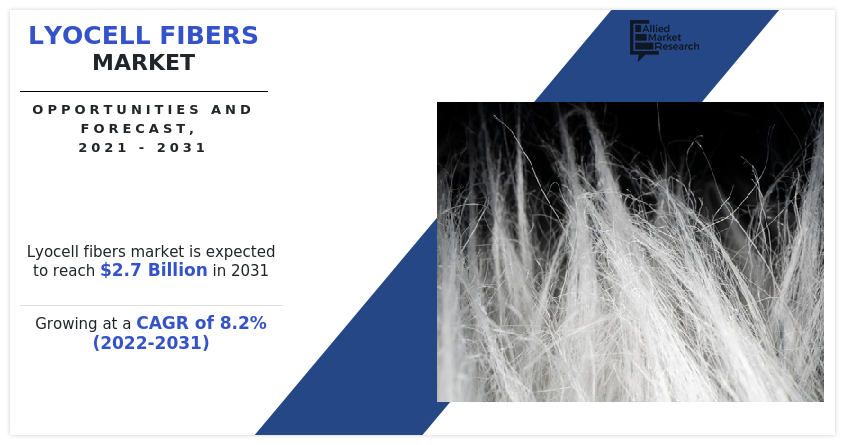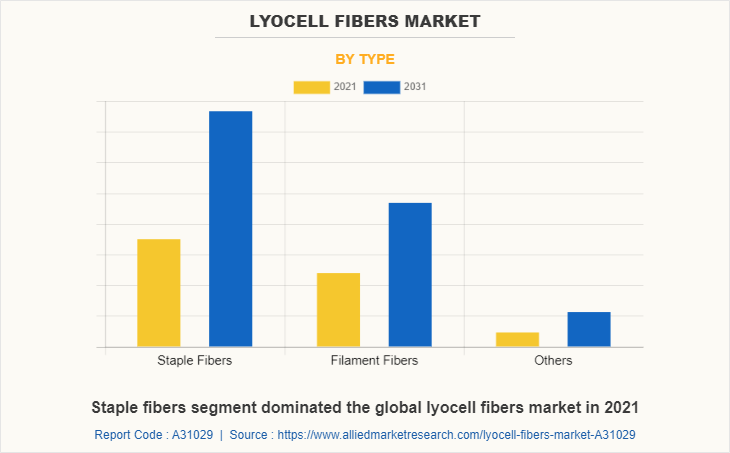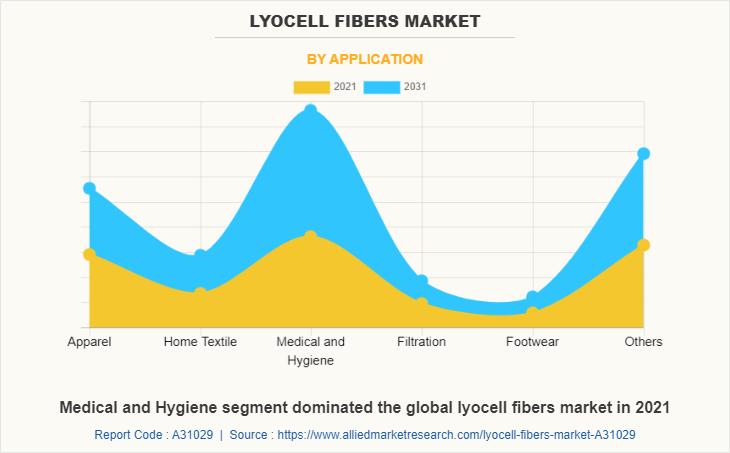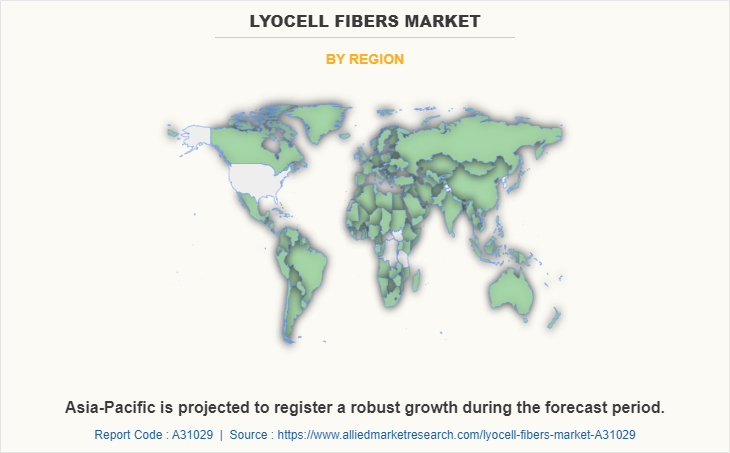Lyocell Fibers Market Research - 2031
The global lyocell fibers market size was valued at $1.3 billion in 2021, and is projected to reach $2.7 billion by 2031, growing at a CAGR of 8.2% from 2022 to 2031.
Lyocell fiber is a form of regenerated cellulose produced by dissolving pulp and dry jet-wet spinning. Unlike rayon produced by some of the more common viscose processes, the production of Lyocell fibers does not use carbon disulfide, which is harmful to workers and the environment. Lyocell fibers have a soft and smooth texture. These fibers are lightweight, breathable, and comfortable. Their elasticity and strength properties make them exceptionally durable materials. Besides, compared to cotton, they have better moisture absorption. These fibers are ideal for sensitive skin owing to their soft feel. Also, the production of lyocell fibers does not require any irrigation process or pesticides. In addition, lyocell fiber is regarded as a sustainable fiber as it is produced from wood and is, thus, biodegradable and compostable.

Moreover, lyocell fibers are frequently used in the production of environment-friendly undergarments, sustainable towels, ethical jeans, and formal shirts. Lyocell fibers is mixed with silk, cotton, rayon, polyester, linen, nylon, and wool. Lyocell fibers are used across many applications such as apparel, home textiles, medical and hygiene, filtration, and others. Lyocell fibers have been shown to have enhanced antibacterial activity against different bacteria and fungus indicating promise use in medicinal or sanitary products. These are used to make newborn diapers as well as surgical coats for doctors and nurses.The increase in demand for lyocell fibers from apparel home, textiles, medical & hygiene, filtration, and other industries is expected to serve as a crucial growth factor for the global lyocell fibers industry.
Lyocell fibers are used in a number of filtering applications, including lightweight tea bag and coffee filter papers, industrial and automotive air and liquid filters, and food and beverage high-capacity depth filters. Lyocell fibers filter media can be utilized in respirators, cleanrooms, furnace filters, vacuum cleaners, and cabin air filters. Lyocell fibers are widely used in various types of filter media with their microfibrillar structure, excellent thermal stability and chemical resistance. These fibers significantly enhance performance attributes of sheet materials including permeability, mechanical properties, pore structure, filtration performance, chemical resistance and formation.
Moreover, lyocell fiber is used in every element of the footwear, including the top fabric, lining, insoles, and laces/zipper/sewing thread, as well as nonwoven fiber in insoles or padding. Lyocell fibers may be used to make impressively moisture-wicking footwear. It can be woven to form a fabric for use in footwear components either on its own or in combination with other yarns. Besides, lyocell fibers have high durability, high moisture absorbency, and high tensile strength especially in wet state. Besides, there is rise in popularity of biodegradable fibers across the globe. Consequently, lyocell fibers find applications in conveyor belts, wipes, ropes, abrasive materials, protective suiting material, automotive seat covers, and battery separators.
Further, developments in the textile industry is another key factor that fosters the market growth during the forecast period. However, availability of the substitute is anticipated to hamper the growth of the global lyocell fibers market. On the contrary, eco-friendly production of lyocell fibers is expected to generate lucrative opportunities for the global lyocell fibers market growth.
The lyocell fibers market is segmented into type, application and region. On the basis of type, the market is categorized into staple fibers, filament fibers, others. On the basis of application, the market is classified into apparel, home textile, medical & hygiene, filtration, footwear, and others. Region wise, the market is studied across North America, Europe, Asia-Pacific, and LAMEA. The lyocell fibers market share is analyzed across all significant regions and countries.
The major players operating in the global lyocell fibers market include Aditya Birla Yarn, Acegreen, Acelon, Baoding Swan Fiber Co. Ltd, Chonbang co ltd, China Pouplas textile ltd, Great Duskan Corporation, Grasim Industrial Limited, Lenzing Group, Shanghai Lyocell fibers, Smart Fiber AG, Weiqiao Textile, Qingdoa Textile Group Fiber Textile, Sateri, and Tamay Fiber Co.Ltd.
Lyocell Fibers Market, By Type

Staple fibers segment dominated the global lyocell fibers market in terms of revenue, in 2021. Lyocell staple fibers are utilized in apparel such as denim, chino, undergarments, casual wear, and towels. These are also extensively used in the manufacturing of heavy-use objects such as coats, blankets, rugs, and wrap threads. The increase in demand for housing products is predicted to boost the demand for coats, blankets, rugs, and wrap threads. This, in turn, is likely to drive the staple fibers segment growth throughout the projected period.
Lyocell Fibers Market, By Application

Medical and Hygiene segment dominated the global lyocell fibers market in 2021. Lyocell fibers is extensively used in the production of infant diapers as well as surgical jackets for physicians and nurses. It is known to exhibit improved antibacterial activity against various bacteria and fungi, indicating that it might be used in therapeutic or hygienic goods. Such growing demand for lyocell fibers in medical and hygienic application is projected to drive the growth of the lyocell fibers market throughout the forecast period.
Lyocell Fibers Market, By Geography

Asia-Pacific is projected to register a robust growth during the forecast period. The growth is attributed to the extensive use of lyocell fibers fibres in medicinal or sanitary products. Also, these fibres are also used for sanitising wipes and overnight bleaching in the food service sector.
Key Benefits For Stakeholders
This report provides a quantitative analysis of the market segments, current trends, estimations, and dynamics of the lyocell fibers market analysis from 2021 to 2031 to identify the prevailing lyocell fibers market opportunities.
- The market research is offered along with information related to key drivers, restraints, and opportunities.
- Porter's five forces analysis highlights the potency of buyers and suppliers to enable stakeholders make profit-oriented business decisions and strengthen their supplier-buyer network.
- In-depth analysis of the lyocell fibers market segmentation assists to determine the prevailing market opportunities.
- Major countries in each region are mapped according to their revenue contribution to the global market.
- Market player positioning facilitates benchmarking and provides a clear understanding of the present position of the market players.
- The report includes the analysis of the regional as well as global lyocell fibers market trends, key players, market segments, application areas, and market growth strategies.
Lyocell Fibers Market Report Highlights
| Aspects | Details |
| Market Size By 2031 | USD 2.7 billion |
| Growth Rate | CAGR of 8.2% |
| Forecast period | 2021 - 2031 |
| Report Pages | 279 |
| By Type |
|
| By Application |
|
| By Region |
|
| Key Market Players | Shanghai Lyocell Fiber, Lenzing Group, Grasim Industrial Ltd., Baoding Swan Fibre Co. Ltd, Sateri Corporation, Tamay Fiber Co., Ltd., Qingdoa Textile Group Fiber, Chonbang Co.Ltd., Acelon Chemicals and Fibre Corporation, Smart Fibre AG, Great Duskan Corporation, Weiqiao Textile Company Limited, Aditya Birla Yarn, China Populas Textile Ltd., Acegreen Eco-Green Material Technology Co.Ltd |
Analyst Review
According to the perspective of the CXOs of leading companies, the global lyocell fibers market is anticipated to grow in near future due to its extensive use in applications such as apparel home, textiles, medical and hygiene, filtration and other end-use industries. Lyocell fibers is used in silkier-looking things such as women's apparel and men's formal shirts. Lyocell fibers may be combined with a wide range of different fibers, including silk, cotton, rayon, polyester, linen, nylon, and wool. It is also used to make conveyor belts, specialty papers, and medical dressings. Thus, wide application scope of lyocell fibers is predicted to drive the growth of the global lyocell fibers market during the forecast period. Further, the Asia-Pacific region is projected to register a robust growth during the forecast period.
The global lyocell fibers market was valued at $1.3 billion in 2021, and is projected to reach $2.7 billion by 2031, growing at a CAGR of 8.2% from 2022 to 2031.
The increase in demand for lyocell fibers from apparel home, textiles, medical & hygiene, filtration, and other industries is expected to serve as a crucial growth factor for the global lyocell fibers market. Also, developments in the textile industry is another key factor that fosters the market growth during the forecast period.
Asia-Pacific is projected to register a robust growth during the forecast period.
Medical & hygiene is the leading application of Lyocell Fibers Market
The major players operating in the global lyocell fibers market include Aditya Birla Yarn , Acegreen, Acelon, Baoding Swan Fiber Co. Ltd, Chonbang co ltd, China Pouplas textile ltd, Great Duskan Corporation, Grasim Industrial Limited, Lenzing Group, Shanghai Lyocell fibers, Smart Fiber AG, Weiqiao Textile, Qingdoa Textile Group Fiber Textile, Sateri and Tamay Fiber Co.Ltd.
Loading Table Of Content...
Loading Research Methodology...



